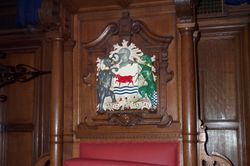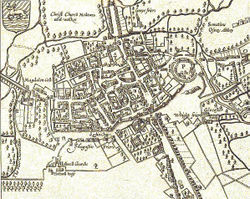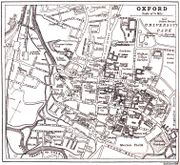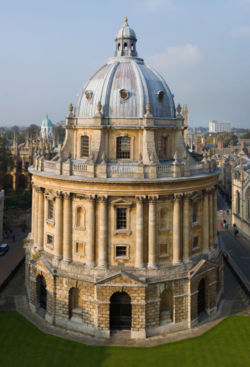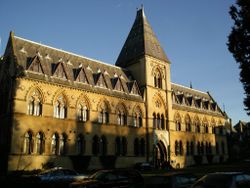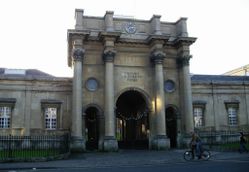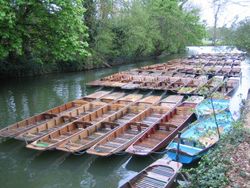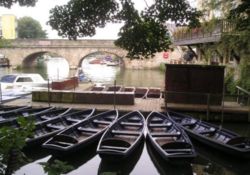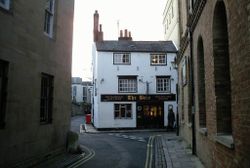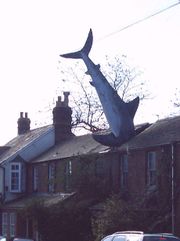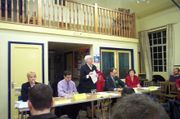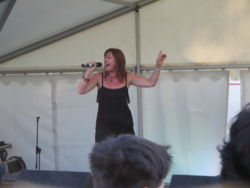Oxford
2007 Schools Wikipedia Selection. Related subjects: Geography of Great Britain
| City of Oxford | |
|---|---|
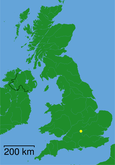 |
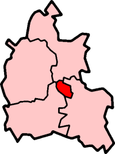 Shown within Oxfordshire |
| Geography | |
| Status: | City (1542) |
| Region: | South East England |
| Admin. County: | Oxfordshire |
| Area: - Total |
Ranked 306th 45.59 km² |
| Admin. HQ: | Oxford |
| Grid reference: | SP 51 06 |
| ONS code: | 38UC |
| Demographics | |
| Population: - Total (2005 est.) - Density |
Ranked 111th 149,800 3,286 / km² |
| Ethnicity: | 87.1% White 4.8% S.Asian 2.5% Afro-Carib. 1.8% Chinese |
| Politics | |
 Oxford City Council http://www.oxford.gov.uk/ |
|
| Leadership: | Leader & Cabinet |
| Executive: | Liberal Democrats (council NOC) |
| MPs: | Evan Harris, Andrew Smith |
Oxford is a city and local government district in Oxfordshire, England, with a population of 134,248 ( 2001 census). It is home to the University of Oxford, the oldest university in the English-speaking world.
It is known as the "city of dreaming spires", a term coined by Matthew Arnold in reference to the harmonious architecture of the university buildings. The River Thames runs through Oxford, where for a distance of some 10 miles it is known as the Isis.
The Oxford suburb of Cowley has a long history of carmaking and now produces the BMW MINI.
History
Oxford was first occupied in Saxon times, and was initially known as " Oxenaforda". It began with the foundations of St Frideswide's nunnery in the 8th century, and was first mentioned in written records in the Anglo-Saxon Chronicle for the year 912. In the 10th century Oxford became an important military frontier town between the kingdoms of Mercia and Wessex and was on several occasions raided by Danes. St Frideswide is the patron saint of both the city and university.
Oxford grew up under the shadow of a convent, said to have been founded by St Frideswide as early as the eighth century. Its authentic history begins in 912, when it was occupied by Edward the Elder, King of the West Saxons. It was strongly fortified against the Danes, and again after the Norman Conquest, and the massive keep of the castle, the tower of St. Michael's Church (at the north gate), and a large portion of the city walls still remain to attest the importance of the city in the eleventh century. West of the town rose the splendid castle, and, in the meadows beneath, the no-less-splendid Augustinian Abbey of Osney: in the fields to the north the last of the Norman kings built the stately palace of Beaumont; the great church of St Frideswide was erected by the canons-regular who succeeded the nuns of St Frideswide; and many fine churches were built by the piety of the Norman earls.
The prestige of Oxford is seen in the fact that it received a charter from King Henry II, granting its citizens the same privileges and exemptions as those enjoyed by the capital of the kingdom; and various important religious houses were founded in or near the city. A grandson of King John established Rewley Abbey for the Cistercian Order; and friars of various orders ( Dominicans, Franciscans, Carmelites, Augustinians, and Trinitarians), all had houses at Oxford of varying importance. Parliaments were often held in the city during the thirteenth century, but this period also saw the beginning of the long struggle between the town and the growing university which ended in the subjugation of the former, and the extinction for centuries of the civic importance of Oxford.
The University of Oxford is first mentioned in 12th century records. Oxford's earliest colleges were University College ( 1249), Balliol ( 1263) and Merton ( 1264). These colleges were established at a time when Europeans were starting to translate the writings of Greek philosophers. These writings challenged European ideology – inspiring scientific discoveries and advancements in the arts – as society began seeing itself in a new way. These colleges at Oxford were supported by the Church in hopes to reconcile Greek Philosophy and Christian Theology.
Christ Church Cathedral, Oxford is unique as a college chapel and cathedral in one foundation. Originally the Priory Church of St Frideswide, the building was extended and incorporated into the structure of the Cardinal's College shortly before its refounding as Christ Church in 1546, since which time it has functioned as the cathedral of the Diocese of Oxford.
The relationship between "town and gown" has often been uneasy — several university students were killed in the St Scholastica Day Riot of 1355.
During the English Civil War, Oxford housed the court of Charles I in 1642, after the king was expelled from London, although there was strong support in the town for the Parliamentarian cause. The town yielded to Parliamentarian forces under General Fairfax in 1646.
In 1790 the Oxford Canal connected the city with Coventry. The Duke's Cut was completed by the Duke of Marlborough in 1789 to link the new canal with the River Thames; and in 1796 the Oxford Canal company built their own link to the Thames, at Isis Lock. In the 1840s, the Great Western Railway and London and North Western Railway linked Oxford with London.
In the 19th century, the controversy surrounding the Oxford Movement in the Anglican Church drew attention to the city as a focus of theological thought.
Oxford's Town Hall was built by Henry T. Hare, the foundation stone was laid on 6 July 1893 and opened by the future King Edward VII on 12 May 1897. The site has been the seat of local government since the Guild Hall of 1292 and though Oxford is a city and a Lord Mayoralty, it is still called by its traditional name of " Town Hall".
By the early 20th century, Oxford was experiencing rapid industrial and population growth, with the printing and publishing industries becoming well established by the 1920s. Also during that decade, the economy and society of Oxford underwent a huge transformation as William Morris established the Morris Motor Company to mass produce cars in Cowley, on the south-eastern edge of the city. By the early 1970s over 20,000 people worked in Cowley at the huge Morris Motors and Pressed Steel Fisher plants. By this time Oxford was a city of two halves: the university city to the west of Magdalen Bridge (from where students traditionally jump into the River Cherwell every May Day morning) and the car town to the east. This led to the witticism that "Oxford is the left bank of Cowley". Cowley suffered major job losses in the 1980s and 1990s during the decline of British Leyland, but is now producing the successful New MINI for BMW.
The influx of migrant labour to the car plants, recent immigration from south-east Asia, and a large student population, have given Oxford a notable cosmopolitan character, especially in the Headington and Cowley Road areas with their many bars, cafes, restaurants, clubs, ethnic shops and fast food outlets. Oxford is one of the most international small cities in Britain with more than 19.3% of the population born outside of the UK and 23.2% from an ethnic minority group, including 12.9% from a non-white ethnic minority ethnic group (2001 Census)
On 6 May 1954, Roger Bannister, as a 25 year old medical student, ran the first authenticated sub-four minute mile at the Iffley Road running track in Oxford.
Oxford's second university, Oxford Brookes University, formerly the Oxford School of Art, based on Headington Hill, was given its charter in 1991 and has been voted for the last five years the best new university in the UK
Twinning
Oxford is twinned with:
 Bonn, Germany
Bonn, Germany Grenoble, France
Grenoble, France León, Nicaragua
León, Nicaragua Leiden, Netherlands
Leiden, Netherlands Perm, Russia
Perm, Russia
All of these are university towns.
Transport
Oxford is located some 55 miles (90 km) north west of London and 70 miles (110 km) south east of Birmingham, and the M40 motorway between London and Birmingham passes within seven miles of Oxford. The A34 road between Hampshire and the Midlands passes Oxford and forms the western part of the city's bypass. The other trunk roads serving Oxford are the A40 road linking London, the Cotswolds and West Wales, and the A420 road between Oxford and Bristol via Swindon.
Rail connections include services to London (Paddington), Bournemouth, Worcester (via the Cotswold Line), Birmingham, Coventry and the north, and Bicester.
The Bicester railway branch is part of the route of a former railway service connecting Oxford and Cambridge that was known as the Varsity Line. Parts of the line have been closed since the end of 1967, but in 2006 the Department for Transport (DfT) has ordered a £300,000 feasibility study to consider reopening it.
The Oxford Canal links Oxford to the Midlands, and connects at Oxford with the River Thames. The Thames provides a navigable link, nowadays chiefly for leisure craft, as far as Lechlade to the west and Teddington Lock to the east and onwards to London.
Oxford Airport at Kidlington offers business and General Aviation services.
Most local bus services are provided by the Oxford Bus Company and Stagecoach South Midlands and include two competing frequent-interval coach services to London, Stagecoach's Oxford Tube, and Oxford Bus's Oxford Espress, both of which leave from Gloucester Green Bus Station on the western edge of the city centre. The Oxford Tube is reputed by its operator to be the most intensive coach service of its kind anywhere in the world. Stagecoach also runs a half-hourly coach service to Cambridge, and a less frequent service to Northampton, whilst many National Express services between the North and Midlands and the South/South West call in the city. Other local and rural bus services are provided by Wallingford-based Thames Travel.
Tourist attractions
Oxford has numerous major tourist attractions, many belonging to the university and colleges. As well as several famous institutions, the town centre is home to Carfax Tower and a historical themed ride, The Oxford Story. Many tourists shop at the historic Covered Market. In the summer, punting on the Thames/Isis and the Cherwell is popular.
Religious sites
- Christ Church Cathedral
- The Church of St Mary the Virgin (the University Church)
- Martyrs' Memorial
Churches in central Oxford
Anglican:
- St Bartholomew's Chapel, Bartlemas, Cowley Road
- Canning Crescent: St Luke, Canning Crescent
- Christ Church Cathedral (Anglican), St Aldate's
- Cowley Parish Church (St James), Beauchamp Lane,
- New Osney, St Frideswide, Botley Road
- St Aldates, St. Aldates
- St Clements, Marston Road
- St Frideswide's, Botley Road
- St Giles', 10 Woodstock Road
- St Margaret, St Margaret's Road
- St Mary Magdalen, Magdalen Street (Opposite Debenhams)
- St Michael at the North Gate, Cornmarket Street
- St Thomas the Martyr, Becket Street
- St Andrew's, Linton Road
- St Barnabas, Cardigan Street
- St Matthew, Marlborough Road
- Parish Church of SS Mary and John, Cowley Road
- Pusey House, St Giles, St Giles' Street
- St Alban the Martyr, Charles Street
- St Ebbe's, Pennyfarthing Place (off St Ebbe's)
- St Cross, St Cross Road (near junction with Manor Road).
- St John the evangelist, Vicarage Road
- University Church of St Mary the Virgin, High Street
There are also two churches that have been converted into college libraries:
- All Saints in the High Street ( 1706- 1708), now the library of Lincoln College
- St Peter-in-the-East in Queen's Lane, now the library of St Edmund Hall
Catholic:
- Catholic Chaplaincy, Rose Place, St Aldate's
- Blackfriars ( Roman Catholic) Dominican Priory, 64 St Giles'
- St Aloysius Gonzaga, Woodstock Road
- St Anthony of Padua, Headley Way
- Greyfriars
Baptist:
- New Road Baptist Church, Bonn Square
- Headington Baptist Church
- Botley Baptist, Westminster Way
- John Bunyan Baptist Church, Crowell Road
- Woodstock Road Baptist
- Albert Street Baptist
Other:
- German Lutheran services at St Mary the Virgin, High Street
- Orthodox Church of the Holy Trinity and the Annuciation, 1 Canterbury Road (off Banbury Road)
- Oxford Unitarians at Harris Manchester College Chapel, Mansfield Road
- Religious Society of Friends ( Quakers), St Giles'
- St Columba's United Reformed Church, Alfred Street
- The Salvation Army, Oxford Citadel, Albion Place
- Wesley Memorial Methodist Church, New Inn Hall Street
- Oxford Vineyard
- Oxford Community Church (OCC) http://www.occ.org.uk/oxford, Osney Mead
- Oxford Bible Church
- Grace Springs Church
- Living Faith international
- The Methodist Church, Lime Walk
- Sant Nirankari Mandal, Marston Road
- Chinese Christian Church, 15 Gorse Leas
- Holy Family Church, 1 Cuddesdon Way
- Evangelical Free Church, Magdalen Road
- Assemblies of God, Oxford, Bracegirdle Road
- Rivers of Life Church, Marston
- Elim Pentecostal, Botley Road
Museums and galleries
University of Oxford:
- Ashmolean Museum, Britain's oldest museum
- Pitt Rivers Museum
- Museum of Natural History, home of (the remains of) the Oxford Dodo
- Museum of the History of Science, in Britain's oldest purpose-built museum building
- Bate Collection of Musical Instruments, St Aldate's
Others:
- Museum of Oxford
- Museum of Modern Art
- Science Oxford
- OVADA
University buildings
(Other than the colleges)
- The Bodleian Library
- The Clarendon Building (often used as a set for film and television)
- The Radcliffe Camera (one of several institutions named after John Radcliffe)
- The Sheldonian Theatre
- The Oxford University Press
Open spaces
The floodplains for Oxford's two rivers reach right into the heart of the city, providing a wealth of green spaces.
- The University Parks
- The University Botanic Garden
- Christ Church Meadow
- Port Meadow
- Mesopotamia
- Angel & Greyhound Meadow
- Cutteslowe Park
- Florence Park
- South Park
Commercial areas
- Cornmarket
- The High Street
- Turl Street
- Little Clarendon Street
- Broad Street
- The Covered Market
- George Street
- Clarendon Shopping Centre
- Westgate Shopping Centre
- Golden Cross
Outside of the City Centre:
- Templers Square Shopping Centre, Cowley, Oxford
- Cowley Road, Oxford
- St. Clements, Oxford
- London Road, Headington, Oxford
- Banbury Road, Summertown, Oxford
- Walton Street, Jericho, Oxford
- Botley Road, Oxford
Theatres and cinemas
- Oxford Playhouse, Beaumont Street
- New Theatre, George Street
- Burton Taylor Theatre
- Old Fire Station Theatre, George Street
- Ultimate Picture Palace, Cowley Road
- Phoenix Picturehouse, Walton Street
- The Odeon Cinema, George Street
- The Odeon Cinema, Magdalen Street
- Vue Cinema
Traditional and historic pubs
- The Eagle and Child
- Turf Tavern
- The Lamb and Flag
- The Bear
- The Trout (at Godstow)
- The King's Arms
- The Chequers
and numerous others, catering for Town and Gown.
Literature in Oxford
Well-known Oxford-based authors include:
- Lewis Carroll (real name Charles Dodgson), Student of Christ Church.
- Colin Dexter who wrote and set his Inspector Morse mystery novels in Oxford. Colin Dexter still lives in Oxford, Wolvercote
- Michael Innes ( J. I. M. Stewart), of Christ Church.
- T. E. Lawrence, "Lawrence of Arabia", Oxford resident, undergraduate at Jesus, postgraduate at Magdalen.
- C. S. Lewis, Fellow of Magdalen.
- Iris Murdoch, Fellow of St Anne's
- Philip Pullman who was an undergraduate at Exeter.
- J. R. R. Tolkien, Professor of English at Merton, and undergraduate at Exeter.
- Ian McEwan, formerly an Oxford resident for many years.
- Mike Philbin, wrote his infamous Hertzan Chimera novels/stories in Oxford.
Many English novels have been set partly or wholly in Oxford. They include:
- Jude the Obscure (1895) by Thomas Hardy (in which Oxford is thinly disguised as " Christminster").
- Zuleika Dobson (1911) by Max Beerbohm.
- Gaudy Night (1935) by Dorothy L. Sayers.
- Brideshead Revisited (1945) by Evelyn Waugh.
- His Dark Materials (1995 onwards) by Philip Pullman
See also books associated with Oxford and the literature section in the University of Oxford article.
Other notable Oxonians
- Noel Godfrey Chavasse, twice awarded the Victoria Cross
- Mike Hailwood, motor cycle world champion
- Tim Henman, tennis player
- John Kendrew, Nobel Prize in Chemistry, 1962
- Martin Keown, footballer
- Martha Lane Fox, internet entrepreneur
- Hugh Laurie, English actor, comedian and writer
- Jane Morris née Burden, Pre-Raphaelite muse
- Robbie Mustoe, footballer
- Garry Parker, footballer
- John Sergeant, journalist
- Emma Watson, "Harry Potter" film actress
- Mark Wright, footballer and manager
Notable bands from Oxford
- Radiohead, debated, as all but one member came from Abingdon.
- Ride
- Supergrass
- Swervedriver
Schools
Oxford is home to an unusual number of highly academic schools, many of which receive pupils from around the world. Three are University choral foundations, established to educate the boy choristers of the chapel choirs, and have kept the tradition of single sex education. However examination results in Oxford schools are consistently below the national average and regional average with the district receiving the lowest average GCSE points score per pupil of any of the 354 districts in England in 2005 (Source: DfES Pupil Annual School Level Census 2005)
- Cheney School
- Cherwell School
- Christ Church Cathedral School (choir school)
- Dragon School
- Headington School
- Magdalen College School (choir school)
- New College School (choir school)
- d'Overbroeck's College
- Oxford High School
- Oxford Community School
- Peers School
- Rye St Antony School
- St Clare's College
- St Edward's School
- St Gregory the Great School
- Summer Fields School
- Wheatley Park School
Geography
Oxford's latitude and longitude are (at Carfax Tower, which is usually considered the centre).
Wards, neighbourhoods, and suburbs
- Barton
- Binsey
- Blackbird Leys
- Botley
- Cowley
- Coldharbour
- East Oxford
- Cutteslowe
- Donnington
- Grandpont
- Headington — home to the Oxford shark.
- Iffley
- Littlemore
- Jericho
- Marston
- North Oxford
- Northway
- Osney
- Rose Hill
- Risinghurst
- Sandhills
- St Ebbes
- Summertown
- Temple Cowley
- Wolvercote
- Wood Farm
Politics in Oxford
Oxford City Council
Despite stereotypes of Oxford being a conservative city, there are no Conservatives on the city council. Since the 2004 local elections, the council has been in minority administration, first by councillors from the Labour Party, with the Liberal Democrats being the official opposition, and since 2006 with these roles reversed. With 8 city councillors and 5 county councillors, Oxford is one of the UK cities with highest Green Party representation. The Independent Working Class Association also has councillors, mainly elected to serve wards with many housing estates in the south east of the city, such as Blackbird Leys and Wood Farm. See Oxford Council election 2004 for further information.
Since 2002, elections have been held for Oxford City Council in even years, with each councillor serving a term of four years. Each electoral ward within Oxford is represented by two councillors, thus all wards elect one councillor at each election. Prior to 2002, the City Council was elected by thirds.
- Partisan Composition
| Year | Labour | Lib Dem | Green | IWCA | Conservative | Source |
|---|---|---|---|---|---|---|
| 2002 | 29 | 15 | 3 | 1 | 0 | |
| 2004 | 20 | 18 | 7 | 3 | 0 | |
| 2006 | 18 | 18 | 8 | 4 | 0 |
- Partisan Control
- 1974 – 1976: Labour
- 1976 – 1980: Conservative
- 1980 – 2000: Labour
- 2000 – 2002: No overall control
- 2002 – 2004: Labour
- 2004 – Present: No overall control
Westminster representation
The two MPs are Andrew Smith from the Oxford East constituency, erstwhile employment minister in the Labour government; and Dr Evan Harris from the Oxford West and Abingdon constituency, sometime Liberal Democrat spokesperson on health. At the 2005 general election, Oxford East became a marginal seat with a Labour majority over the Liberal Democrats of just 963. Oxford West & Abingdon is a safe Liberal Democrat seat with Dr Harris enjoying a majority of just under 8,000.
Alternative culture
There is also a large and vibrant alternative political culture mostly situated in East Oxford. Some examples are:
- Oxford BOP Samba
- Oxford Student Activist Network
- Undercurrents
- OCSET
- Oxford Action Resource Centre (OARC)
- Campaign to Close Campsfield
- Corporate Watch
- ETC Group
- Oxford Indymedia
Parishes
Unusually for a compact urban district, Oxford has four civil parishes with parish councils — these are Blackbird Leys, Littlemore, Old Marston and Risinghurst and Sandhills.
